During the weekend in Bucharest there would be 7 of us. There were 4 people from my village (Paco, Nacho, Pedro and myself), one guy from my village who was living in France (Manolo), one guy from Barcelona (Pau) and another one from Mexico (Fabrizio). I had met the last two while doing Erasmus in Sweden and while finishing my studies in California. That’s one of the things I love the most about travelling: making friends you can meet later on in any part of the world.
So, Paco, Nacho, Pedro and myself were starting the trip from Jaén. We drove all the way to Madrid and, after leaving the car at SHS office, we were taken to T1. They have very good prices. We paid 42 euros and that included leaving the car in the parking for 10 days and the transport from their office to T1 and back. Thus, in case you are going to fly from Madrid and don’t know where to leave your car, check it out!
It was 05:00 and our flight was taking off at 07:00. We had to wait a couple of hours but, nonetheless, we would be the first ones arriving in Bucharest. Then, there would come Fabrizio, Pau and, lastly, Manolo. I couldn’t wait for it. Back on 2016 I had been in another “Eurotrip”. That time we visited Berlin, Prague, Vienna and Budapest. We spent around 7 days and we felt like we needed more. That’s why, this time, we were going to spend 10 days between Bucharest, Brasov, Sibiu, Timisoara and Belgrade. We would also check out some beautiful castles within Transylvania but… that’s another story. I’ll let you know about all that later on in other posts 😉
How to get from Otopeni Airport to Bucharest?
When I travel alone I try to use the cheapest option. In this case, we were 4 of us and, to get from Otopeni Airport to Bucharest, would take us around 1 hour by public transport. You have different buses that go from the airport to the city center of Bucharest. For further info: https://www.bucharestairports.ro/en/transport/bus
In our case, we had done some research before arriving in Bucharest and that’s why we decided to grab an Uber. They were pretty cheap and there were plenty of them around. We paid 53,33 RON (around 11 Euros) and our kind driver took us to our hostel.
That day was Friday and it was a bank holiday (All Saints’ Day) in many countries (but not in Romania). Not sure why but there was a huge traffic jam. Nonetheless we enjoyed the ride. We spoke with our driver about many things. He told us he worked full time in an IT company but he was also doing Uber part time to be able to provide for his two kids and his wife. He had been working for the same company for 10 years but the salary hadn’t raised much. As we were driving, he also recommended us some places to go grab some food and told us that no, the river we were seeing wasn’t the Danube, but the Dambovita. Danube does flows through Romania but not through Bucharest 🙂
Where not to stay in Bucharest?
We had booked two rooms at “First Hostel Bucharest” for Friday and Saturday nights. As I mentioned before, we were 7, so, we sent them an email stating we wanted to stay in 2 rooms, 4 people in one and 3 people in another one. They said that was feasible and we shouldn’t have any problems… Well, as soon as we checked-in, the guy at the reception told us “he thought” it would be better for us to be divided in 6 and 1. He decided that on his own, without asking us. We told him that’s not what we had agreed upon and he said he was sorry but it was too late now and there were no other rooms available…
The hostel has an score of 9 in Booking but, to be fair, that’s a little bit too much. It wasn’t just about the arrangement of the rooms. The hostel was not very clean, the reception wasn’t open 24 hours, the breakfast was kind of too lame and, the cherry on the cake would come the next day, when some of us realised we had been bitten by bedbugs… To sum up, sometimes the score of a hostel in Booking may not reflect its real value. Thus, if you come to Bucharest, try to avoid First Hostel Bucharest, you will thank me later.
About Bucharest
Bucharest is the capital and largest city of Romania. Romania entered the European Union in 2007 but they still conserve their own currency: LEI or RON. 1 LEI is around 0,20 Euros. There are some places where you can use Euros, like when renting a vehicle or paying some services. But, overall, when you come to Romania, you should withdraw or exchange Euros to LEI. That being said, during our trip, some locals told us they would start using Euros in a couple of years… I guess you know the meaning of that, right? Prices will shoot up. So, go to Romania now! 🙂
Bucharest might not be the typical city you consider as a travel destination in Europe, but, after reading this post, you might change your mind. The city is pretty new, due to all the damages occurred during war, earthquakes and Nicolae Ceaușescu’s Communism. Because of that, the city has a lot of interesting history. The architecture mixes styles as different as Art Nouveau, Art Deco, Communism and Modern.
The language, being a latin one, seems to be a mix of Italian, Spanish, Catalan and French, being more predominant the Italian part. Sometimes, as we were walking around, I would hear people talking and I would thought I was in Italy, rather than in Romania lol. Just to give you an example, when entering to some shops, people would welcome you with the word “ciao”.
And last but not least, if you like partying, this city has it all: from bars, to pubs to clubs. From narguiles to beers to cocktails. If you live in one of those countries where clubs close at 3 in the morning, don’t worry. You have no excuse to go home before sunrise while in Bucharest. And, watch out, because once you get lost in one of its party streets, you may need to call your friends to get you out of there 😉
Day 1 in Bucharest
As I was saying, we weren’t very happy about First Hostel Bucharest but, we had already paid for it and the weekend in Bucharest was about to start so, we tried not to think too much about it. Nacho had made a list in Tripadvisor about the best restaurants in each one of the cities we would be visiting during our Eastern Europe trip. Thus, we trusted him and, after leaving the hostel, started walking towards Piata Unirii (Union Square). To be fair, not everything was bad about the hostel. The location was pretty convenient.
Lunch at Manuc’s Inn
After 10 minutes or so we were at Piata Unirii and, from there, we kept on walking till we arrive to a huge building. The building’s name is Manuc’s Inn (Hanu’ Lui Manuc in Romanian). By the middle of 19th century it was Bucharest’s most important commercial complex. Thus, no wonder I found it huge! Manuc’s Inn has been subject to many restaurations throughout centuries and, it was in 1949 that it was nationalized. As of now, it is the oldest operating hotel in Bucharest and it houses a restaurant, several bars, a coffe house and several stores. So, let’s say Hanu’ Lui Manuc is not just the average restaurant 😉
We entered the restaurant and they asked us if we had a reservation. It seemed the whole place was occupied, crazy! We told them we had just arrived and we had no reservation so they made us walk through a gallery, from where we could see a whole courtyard full of tables and chairs. Those places were not occupied due to the autumn season, but I guess they will be all occupied in spring and summer. We finally got our table at another dining room and started ordering. P.S: If you don’t want to risk it, book a table in advance!
Prices were medium-high. The menu of the day though was super cheap (6 euros) and it included a cabbage salad, a soup, a main dish and its garnish. We ordered a beer from Timisoara (more on this city in future posts) and a cheese “soup”. The soup was made of mamaliga (Romanian polenta), sour cream and cheese. It looked like this:
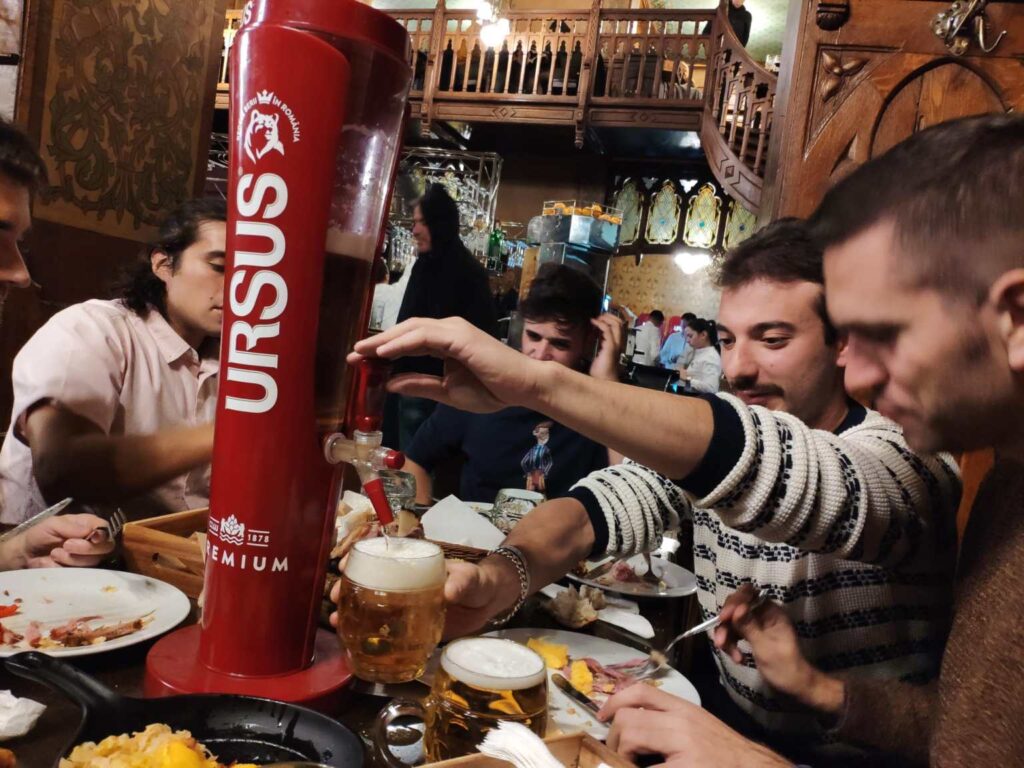

The food was pretty good and so the whole restaurant, its setup and the people working there. When we were about to finish, Fabrizio told us he had just arrived at Piata Unirii and he was joining us. We waited for him with a house wine pitcher. It was so nice to see him after 3 years! We had met back in California in 2013 and our paths crossed again in Barcelona in 2015 and 2016.
We let him order and finished his food as we were drinking the wine. Once we were all done, we ordered “Pálinka” shots. The Pálinka is a traditional fruit brandy in Central Europe, with origins in Hungary and invented in the Middle Ages. It can be made of any locally grown fruits but, the most common ones are plums, apricots, apples, pears and cherries. It looked like this:
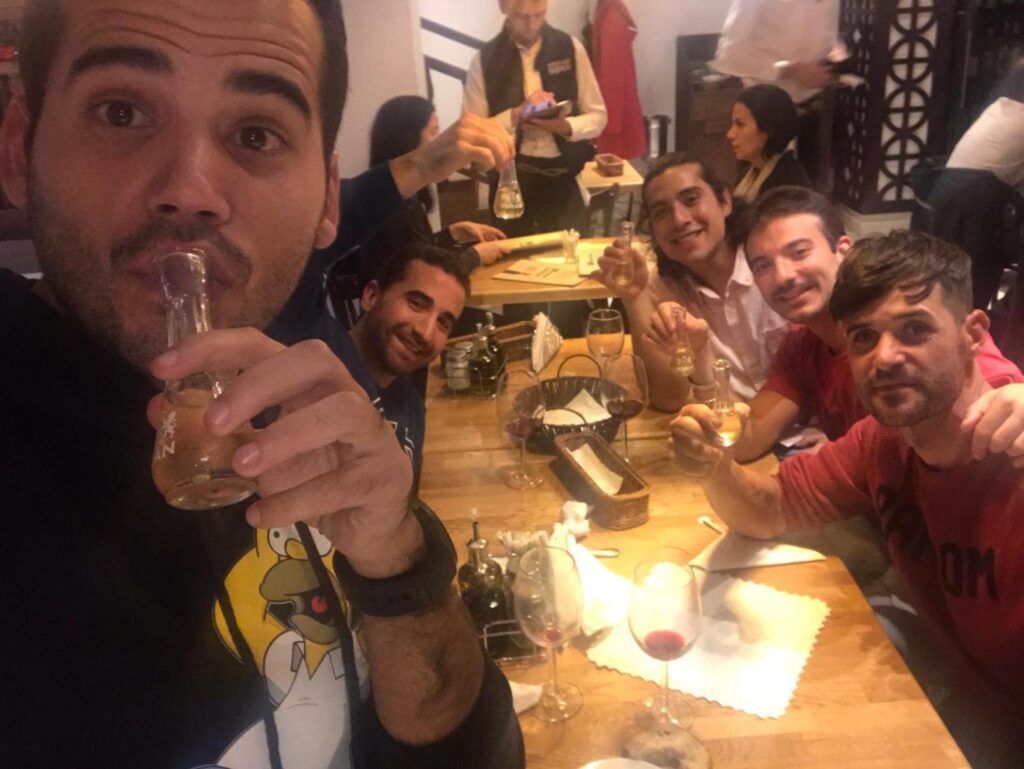
Bucharest fountain show
We left Manuc’s Inn pretty “happy” after all the food and drinks. Pau had just called us and he was waiting for us at the fountain of Piata Unirii. Before the weekend in Bucharest, I had done some research about what to do and see and, one of the highlights, was the fountain show at Piata Unirii. The problem? We had arrived just a little bit too late.
The schedule of the show is every week between May and October on Friday, Saturday and Sunday. The show starts at 21:00 on May, at 21:30 on June and July, at 21:00 on August and at 20:00 on September and October. And, guess what? We had arrived in Bucharest on November the 1st, so, we had just missed it! Nonetheless, even if it wasn’t the “proper” show, as we approached the fountain, we saw something like this:
We took some pictures and played with the water and, after several calls, we finally found Pau. The fountain is pretty big so, if you are going to meet up with someone there, make sure to provide a precise and unique location. I had last seen Pau in December 2018. Back then I had just arrived in Spain after my Work and Holiday in Australia and after my 3-month trip in South East Asia. Again, it was nice to see him after almost a year.
We walked back to the hostel, bought some beers and waited for Manolo there. As he was approaching the hostel, he started sharing his location. Like that, we knew when to walk outside and wait for him with a beer. Once everybody met each other, the 7 of us were finally ready for the weekend in Bucharest.
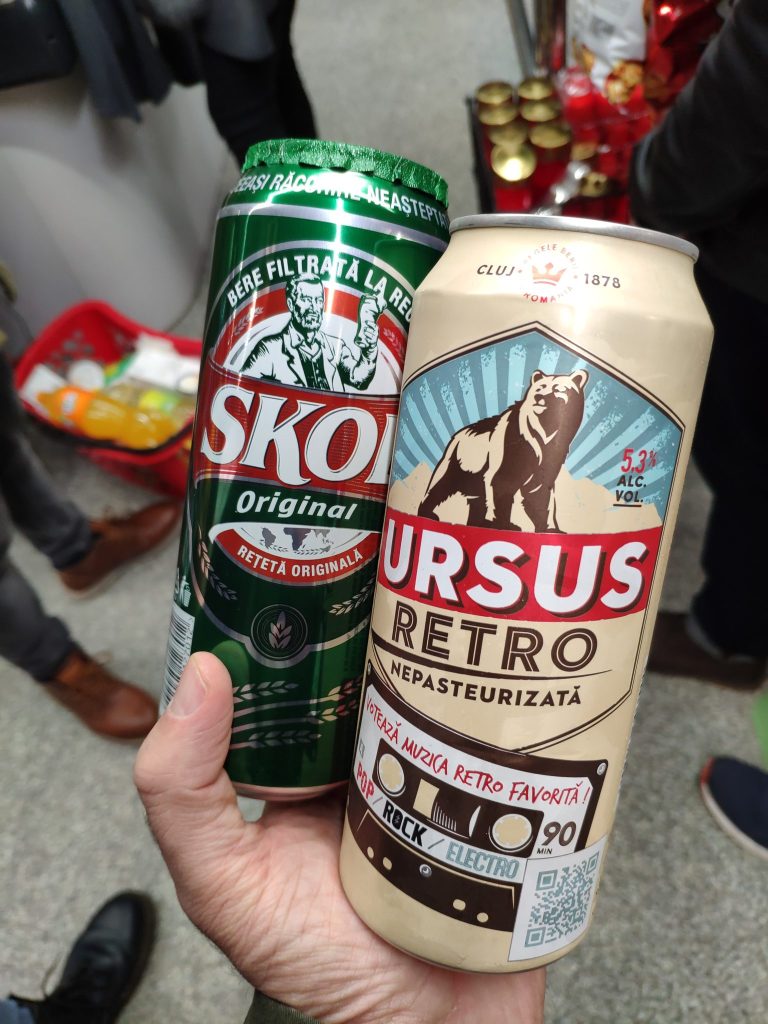
Dinner at Caru’ cu bere
Manuc’s Inn is huge but, sometimes size does not matter, right? I really liked Caru’ cu bere from the moment we stepped in. The decoration was superb. However, as I was appreciating all the details, a waitress came and told me that if I had no reservation I could give her my name and wait for about 30 minutes. What? So, if I told you before that to go to Manuc’s Inn you might want to book a table, when it comes to Caru’ cu bere, you absolutely need to book it before going.
Caru’ cu bere (“the beer wagon”) was opened in 1879 and moved to its current location, a Neo-Gothic building by Austrian architect Siegfrid Kofczinsky in 1899. The building is classed as a historic monument and it is richly decorated with paints, stained glass, mosaics and carved panellings.
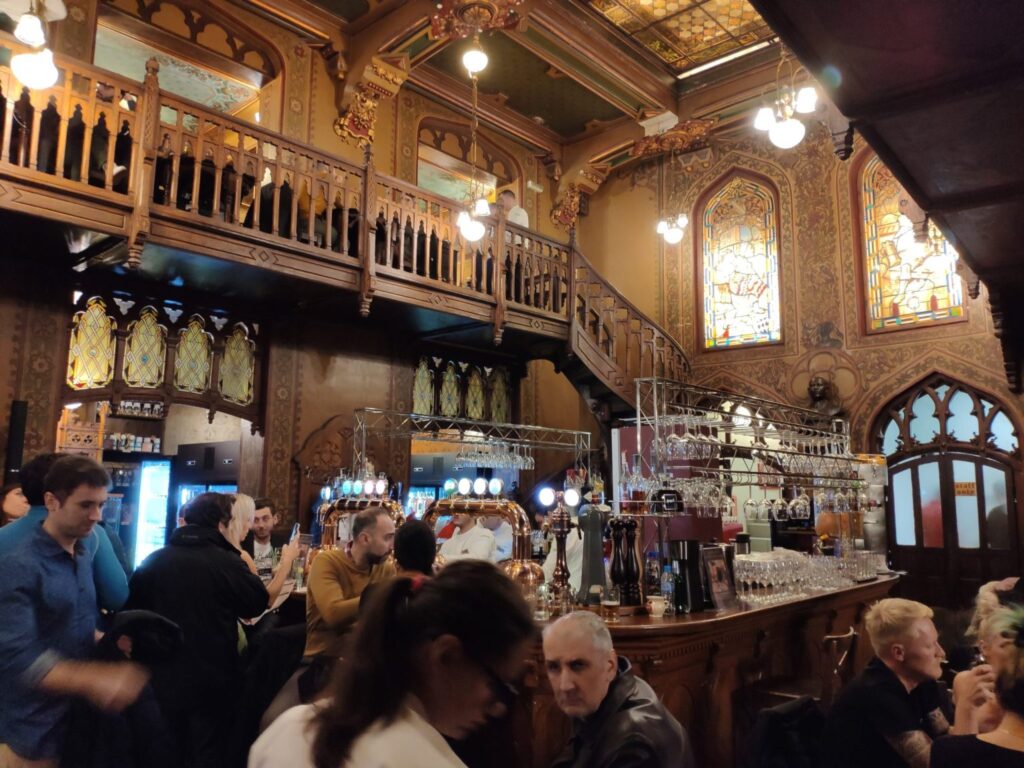
While waiting, the waitress told us we could go have a drink at the bar. We walked there, awing to the decoration of the building as well as to the amount of people inside. It had two stories and all the tables were occupied! But the same went for the bar. We had no room whatsoever and we were kind of in the way of the waiters. As we were there, a show started to take place. They were performing traditional Romanian dances. It was pretty cool and it looked like this:
We saw people leaving and we asked the waitress if we could take the table. She said it was booked. 5 minutes later though she came back and told us we could use it. Yeah!
We ordered 0,5 l beers for everyone as well as pig knuckles and “mici”. Mici is a typical Romanian dish which literally means “small ones”. They are some sort of small sausage-like portions made of minced pork and beef mixed with garlic and spices.
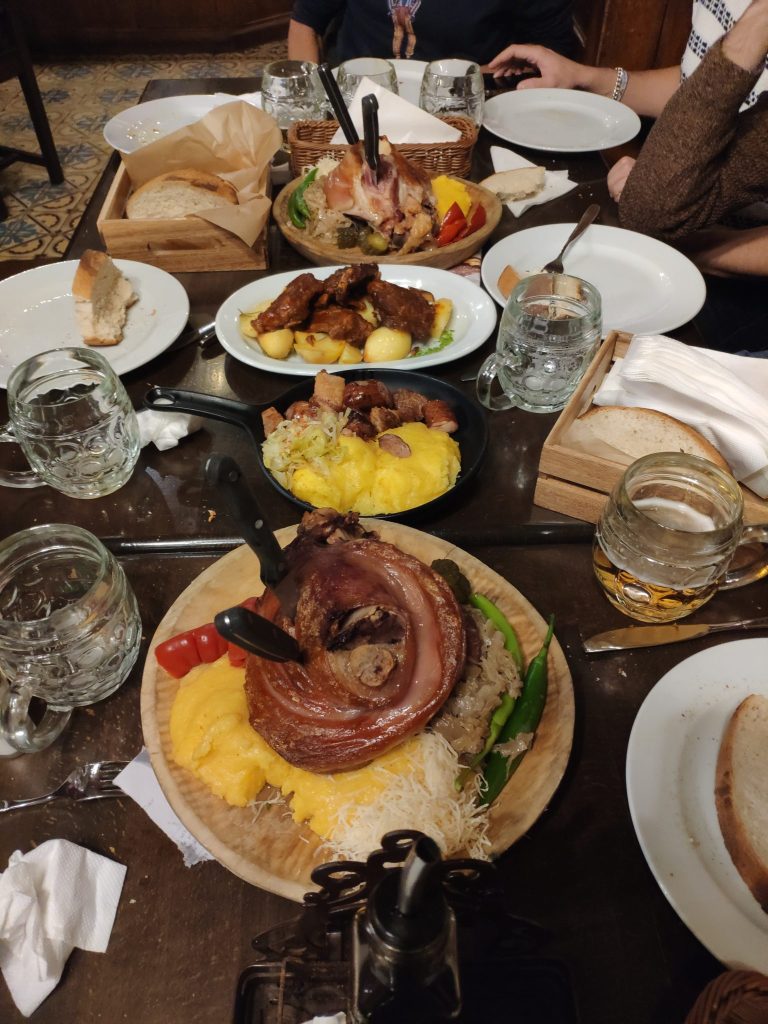
Due to all the thirst the meat gave us, we couldn’t help but ordering a 2,5 l beer tank. It looked like this:

The food was pretty good. We could say the place is a touristic one, but it is also well seen within the local community. The ambience was amazing and the service was correct. Prices were medium-high but, if you go in a big group like us and order to share, you should be alright 🙂
Partying in Old Town Bucharest
We asked one of the waitresses where we could go party in Bucharest. She told us we just needed to turn left after leaving Caru’ cu Bere and, from there, turn right at the first corner. She said we would find anything we were looking for there, and she was right lol.
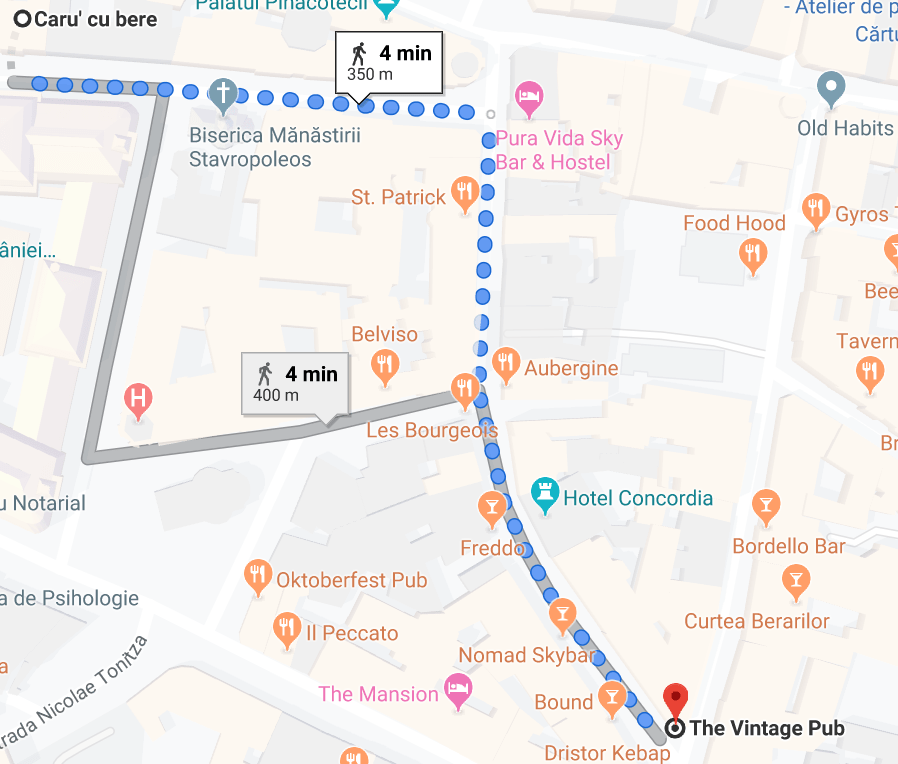
As soon as we entered “Strada Smardan” I felt I had travelled back in time. Strada Smardan made me feel I was back at Paceville in Malta. There were so many bars and pubs that we didn’t even know where to start. There were so many people that it seemed like streams of ants. It was Friday night and the city was on fire.
We made it to a couple of places where they told us they were hosting private parties and we couldn’t stay. No problem sir. There were so many options that we just kept walking. We made it to a pub/club and we ordered some drinks. Every single place was completely full. After an hour or so providing people with free dance lessons, we left the place and kept on walking, following the stream of people.
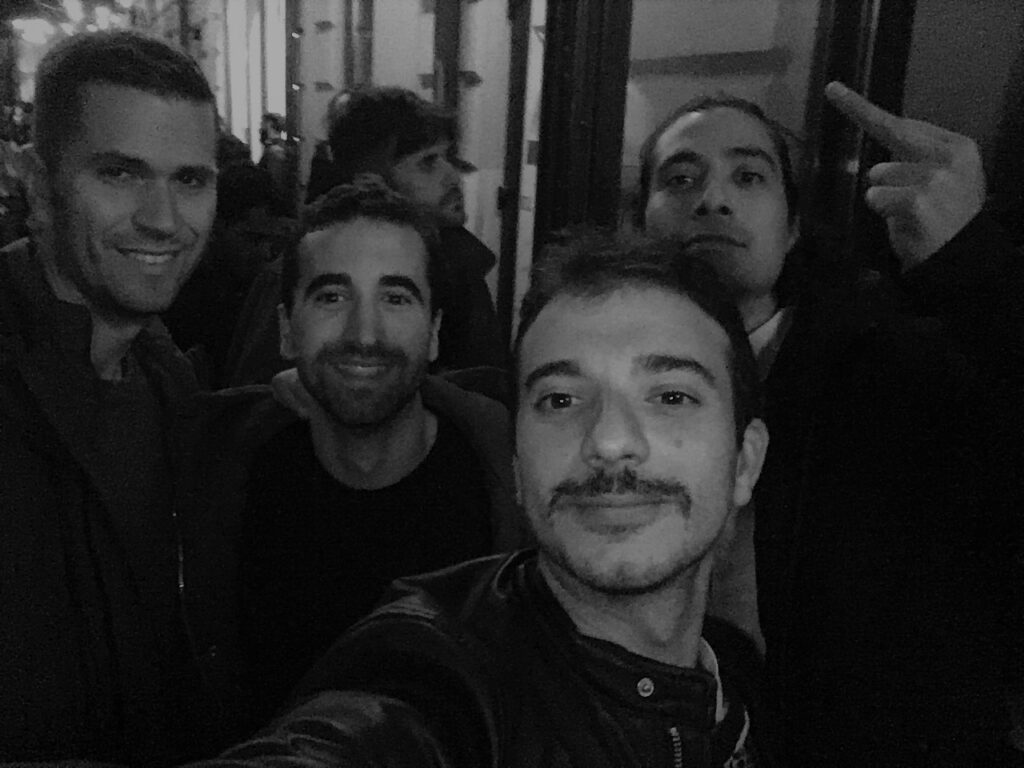
That stream took us from Strada Smardan to “Strada Lipscani”. And, that’s how we made it to “El Dictador”. Although the name was contrary to our political beliefs, the ambience, the music and the drinks fitted us properly. It was smaller than the previos place but we liked the atmosphere better. We could say it was more “authentic”. El Dictador is in a narrow street full of more bars and pubs. Again, there were so many party options in Bucharest… crazy!
We spent most of the night there. The drinks started to take effect on us and, when I realised, I was alone with Fabrizio. The rest had “disappeared”. For a while, I though Bucharest had them, like in Hangover 2 lol. But, after a few phone calls, we found Nacho next to “El Comandante”. Yes, the name of that place fitted him much better. We rescued him and started walking towards “Kristal Glam Club”.
We walked there because apparently it was some sort of an electronic music venue and we thought it was the perfect way to finish the night. At the entrance, they asked us for around 20 Euros and, after thinking about our condition, we decided it was better to go to sleep. We waited for the rest of the team and, after ordering 2 Ubers, we made it back to the hostel. What a way to start the weekend in Bucharest!
Day 2 in Bucharest
Nacho had booked a free tour with Guruwalk about the History of Bucharest for Saturday at 10:30. So, after waking up and going to “Mega Image” (a nearby local supermarket) to buy some breakfast, we started walking to Piata Unirii. There were people already waiting as well as two guides (the tour could be done in English or Spanish). We met Alina, our Spanish tour guide and, at 10:30, we started the tour.
Free tour about the History of Bucharest
From the very first moment Alina showed herself both as a kind and knowledgeable person. Her Spanish was pretty good. She loved what she was doing and you could feel it. Along with her, she brought a dossier full of big pictures which she used to reinforce the explanations she was giving us. She was self-employed and the business was going well. Thus, because she loved travelling, she was taking days off now and then. Sometimes I thought about working as a tour guide. You can travel, make some money and meet a lot of people… Who knows? 🙂
Piata Unirii
We started the tour in Piata Unirii. This emblematic square is one of the largest in central Bucharest. Piata Unirii is a logistic center on Unirii Boulevard where metro, bus and taxi stations gather. You can also find a shopping mall and restaurants as famous as Manuc’s Inn. The square is divided in different roads and fountains. It looks like this:
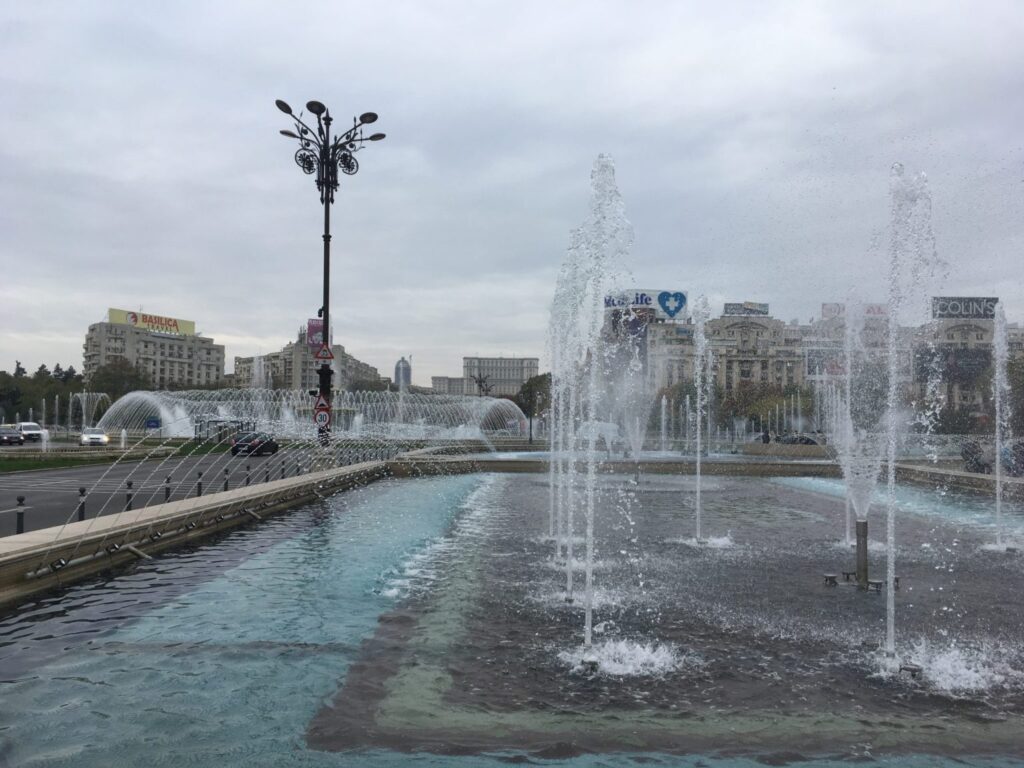
It is bisected by Unirii Boulevard, originally built during the Communism era as the “Boulevard of the Victory of Socialism” and then renamed after the Romanian Revolution. The 1977 earthquake gave Nicolae Ceaușescu the perfect excuse to demolish parts of old Bucharest. He wanted to create a civic center which resembled the one of North Korea. He also wanted to show how powerful he was. Thus, he built Boulevard Unirii as the Communist Romanian’s answer to Pari’s Avenue des Champs-Élysées. The cherry on the cake and the tip of Boulevard Unirii is the (in)famous huge Parliament, which you can see from Piata Unirii.
Nicolae Ceaușescu’s Communism
From the moment Alina started talking and throughout the tour, we could feel she wasn’t in love with Communism. I won’t talk about my political preferences here but, as she started telling us more and more about Nicolae Ceaușescu, I felt like most of the problems the country experienced wasn’t “due to” Communism but due to his ruler. He was a dictator who didn’t care about his people and I think that transcends ideologies.
He became the leader of the Romanian Communist Party in 1965. Two years later, he consolidated his power by becoming president of the State Council. From the very first moment he wanted to make Romania independent of the power of the Soviet Union. That, as you imagine, didn’t have a positive welcome on the Russian giant. He sent many political opponents to prison, made abortion illegal and made divorce more difficult.
During his visit to North Korea, he took great interest in the idea of total national transformation. He liked the power and way of ruling of Kim II-sung and he felt like he would like to make Romania the new North Korea. To that extend, he demolished most of Old Town Bucharest and started to build a new Civic Center. Among the highlights, he also started the construction of the Parliament, the second biggest building in the world (just behind The Pentagon).
During all the demolitions that took place in the city of Bucharest, Eugeniu Iordachescu became “the engineer of heaven”. He was a civil engineer who came up with a way to save some of the buildings that were in the way of Nicolae Ceaușescu. He literally moved the buildings from one place to another, something unthinkable back then. In order to achieve that, he lift the buildings and put them in railway tracks. Alina showed us some incredible pictures about that milestone. You can find more info (as well as some pictures) on that in the following links:
- https://www.theguardian.com/cities/2016/dec/14/bucharest-moved-churches-safety-communist-romania
- https://www.rferl.org/a/romania-bucharest-architecture/29697331.html
The dictator spent almost a decade trying to repay the debt the country of Romania had. To that extend, he ordered the export of much of the country’s agricultural and industrial production. Food rationing was introduced and heating, gas and electricity blackouts became the rule. That made Romanian’s everyday lives a fight for survival. Alina told us how she remembered the uncountable hours waiting in the line of a supermarket to buy some food. Many times, after all those hours, she would find there was no food left.
So, he made Romania the richest country in the world, as in 1989 the debt was paid. But, in the meantime, he made his people of one the poorest in Europe. Not to mention all the suffering they went through.
On December the 17th, 1989, a revolution started in Timisoara. People were killed that day but that led to a bigger revolution. On December the 21st, many people rioted in University Square in Bucharest, after having learnt about the incidents in Timisoara. It was the next day, once the revolution had spread throughout the country, that many people inside Nicolae’s army switched sides, turning their backs on him.
He fled the capital with an helicopter but the pilot told him they had to land due to anti-aircraft fire danger. They stopped a car and a man, named Nicolae Decă, drove them to Văcărești. After that though, he informed the local authorities, which, by then, were on the people’s side. The Ceaușescus took another car and told its driver, Nicolae Petrișor, to drive them to Târgoviște. Petrișor took the couple to an agricultural center near Târgoviște, where the Ceaușescus were locked in an office and were later arrested by soldiers from a local army garrison.
On Christmas Day, 25th of December, 1989, Nicolae and Elena Ceaușescu were executed at a military base outside Bucharest. The person who replaced him in power was Ion Iliescu, the former right-arm of Nicolae. Ion was surrounded by controversies and, according to our guide, he had a lot to do with the end of Nicolae. Apparently, he was being controlled by the Soviet Union, who saw Nicolae Ceaușescu and his desire of becoming independent from them as an obstacle… What do you think?
St Anthony Church
Our next stop in our tour was the “peculiar” St Anthony church. It was built in 1559 by Mircea Ciobanul, who was ruling Wallachia back then. So, Wallachia was one of the three regions (along with Transylvania and Moldavia) that made the country of Romania before it became what we know nowadays. St Anthony church is the oldest church in Bucharest preserving its original state.
The architecture is both peculiar and beautiful, with facades decorations specific of the Wallachian 16th century religious buildings. It alternates rows of brick with plaster.
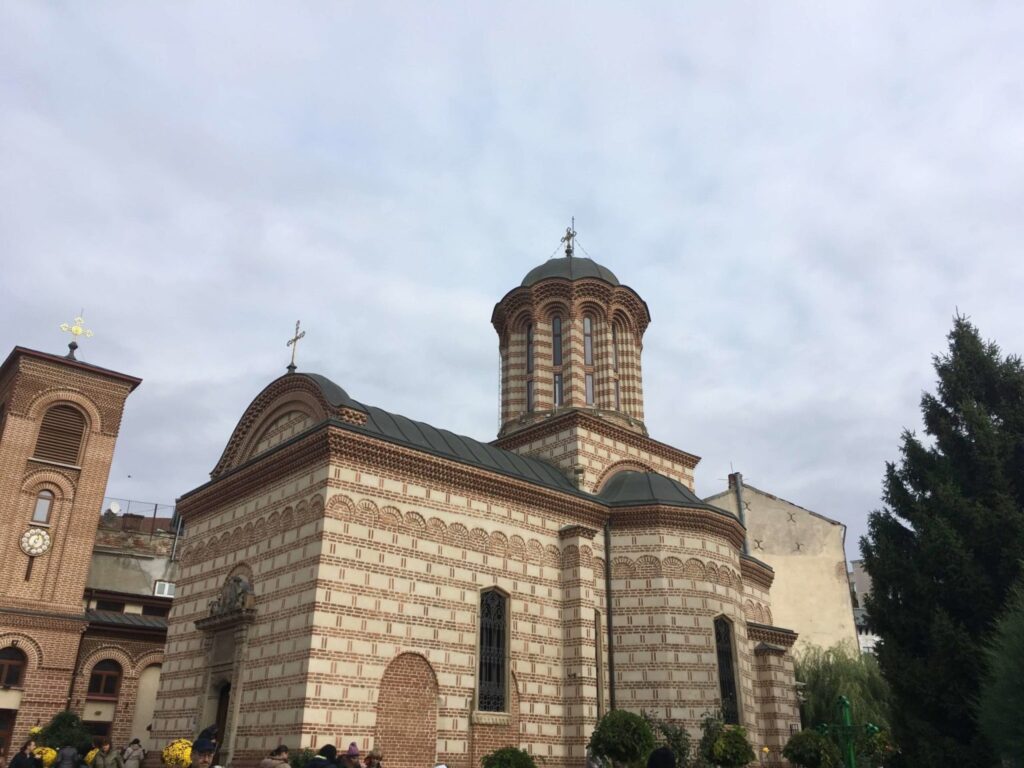
According to some cultures, St Anthony is known for his love miracles. Therefore, many people turn to him when they want to find love. Because of that, Alina (joking) told us we should think about extending our time in Bucharest till Wednesday. Why? Because if you visit St Anthony church on Tuesday evening, you will find plenty of girls there. They will be praying to St Anthony, asking to find love. Who knows? You could be the lucky one 😉
Stavropoleos Monastery
From St Anthony church we walked to Stavropoleos Monastery. The church and monastery were finished in 1724 by the Greek monk Ioannikios Stratonikeas. In 1726 the monk became a Metropolitan of Stavropolis and ever since the monastery was renamed after him. The 19th century marked the decay of the monastery, damaged by demolitions, fires and earthquakes. The monastery was rebuilt in the early 20th century following the plans of architect Ion Micu, who designated it in the Neo-Romanian architectural style of the time. As of now, it looks like this:
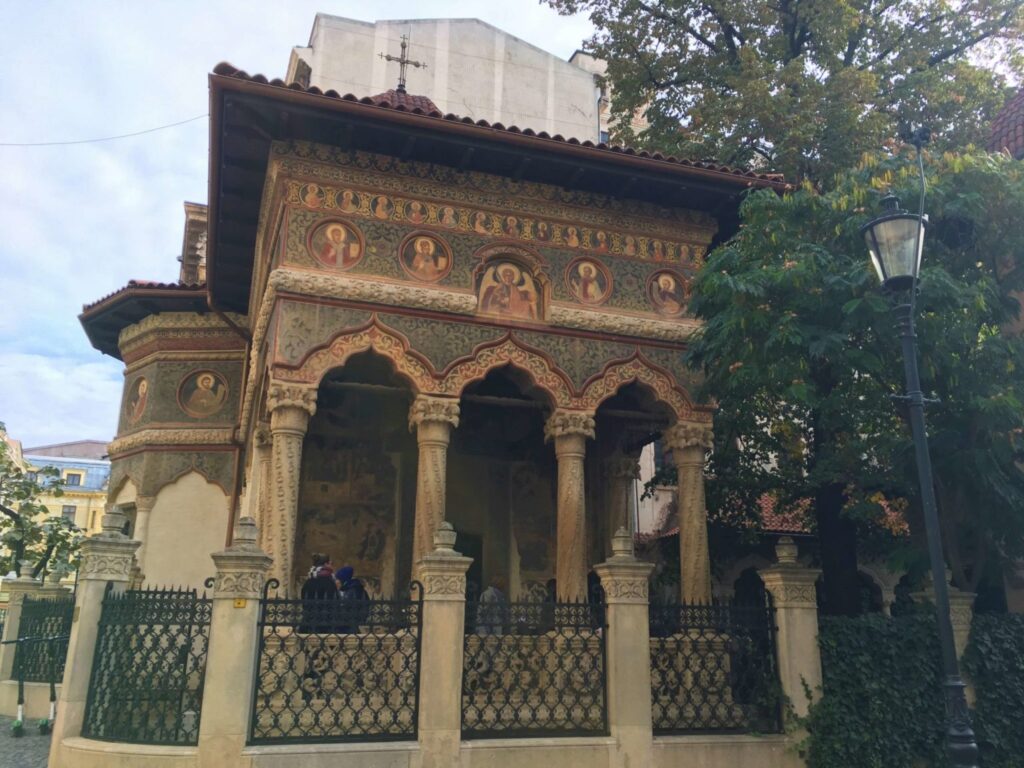
The community living there nowadays (mostly nuns) is engaged in renovating books, icons and sacerdotal clothes (along with worship). One of the peculiar things about this monastery is that its choir sings Byzantine music. So, depending on the time you go visit the monastery, you could run into a musical surprise 🙂 The library of Stavropoleos, which has over 8000 books of theology, Byzantine music, art and history, has the largest Byzantine music books collection in Romania.
When we made it to the inside, we run into people eating something similar to rice and drinking from small plastic glasses. We were not sure about what was going on until Alina explained it to us. So, as we happened to be there on November the 2nd, they were celebrating the All Saints Day. Because of that, they were offering to everyone in the monastery some sort of a rice-based dessert along with dried fruits and nuts and home-made wine. The weekend in Bucharest had it all!

The unbreakable Romanian banknotes
We were not far away from University Square, also known as “21 December 1989 Square”, due to its importance during the Romanian Revolution. It was going to be the last stop of our amazing free tour about the History of Bucharest. All of a sudden, Alina indicated us to stop and asked who could break a Romanian banknote.
We were a little bit surprised lol. Fabrizio stepped in and tried without success. We couldn’t believe it. It was then that she explained to us the history of the Romanian currency. And, among the highlights, was the fact that the RON or LEI is, along with the Australian dollar, the only unbreakable banknote in the world. And why is that? Because they are printed on plastic polymer 🙂
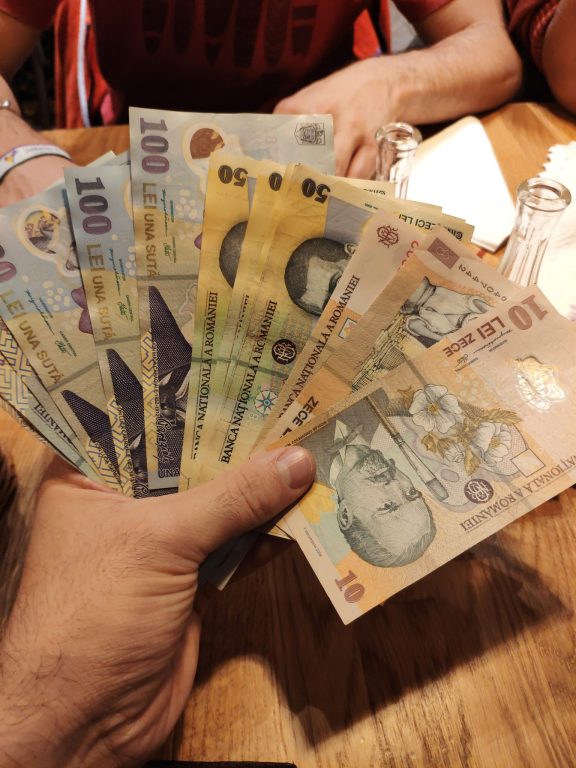
We walked to University Square and our free tour about the History of Bucharest came to an end. We thanked Alina for her time and work. It was a truly remarkable free tour, one of the best of my life. We walked along with her for some meters as we were going in the same direction. She told us she felt like the situation of Romania had improved quite a lot. She was happy with her job and with the days off she could take, which she spent on travelling around the world. As a final service, she advised us to go have lunch at City Grill. Thanks for a great tour Alina, so long!
Lunch at City Grill
We told Alina we wanted to try “sarmale” and “papanasi” and she told us to go to City Grill. There are a few different City Grills in the Bucharest and we went to the one in downtown: City Grill Covaci. The restaurant was pretty cool. It had a couple of stories and there was a cook on the first one working just on the grill. We went upstairs and, after getting our table, started ordering. Like back at Manuc’s Inn and Caru’ cu bere, we had an amazing time. The food was delicious although the service was a little bit slow. Prices were medium-high.
In case you are wondering, sarmale is a typical Romanian dish. It is made of minced meat (usually pork or in combination with poultry) mixed with spices, rice and onions. All the ingredients are rolled up in sour (fermented) cabbage leaves, and boiled for hours in a special sauce made of sauerkraut juice, tomato juice, and other secret ingredients. It normally comes with polenta as a side and it looks like this:
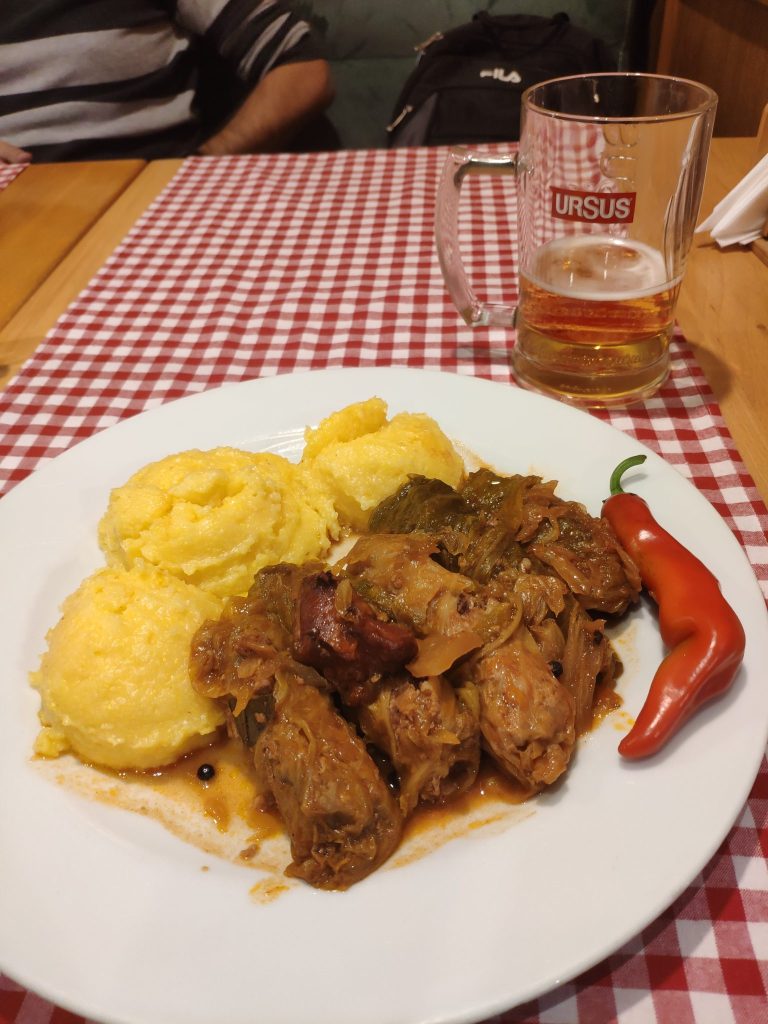
And last but not least, papanasi is a typical Romanian dessert. This caloric bomb was originated in the northern part of the country. It looks like a donut but the inside of the hole is covered with cottage cheese and semolina mixture. It normally comes with sour cream and jam on top and usually a single order comes with two pieces. My advice, if you are two, order just one. We were 7, ordered 4 and struggled to finish the last one.
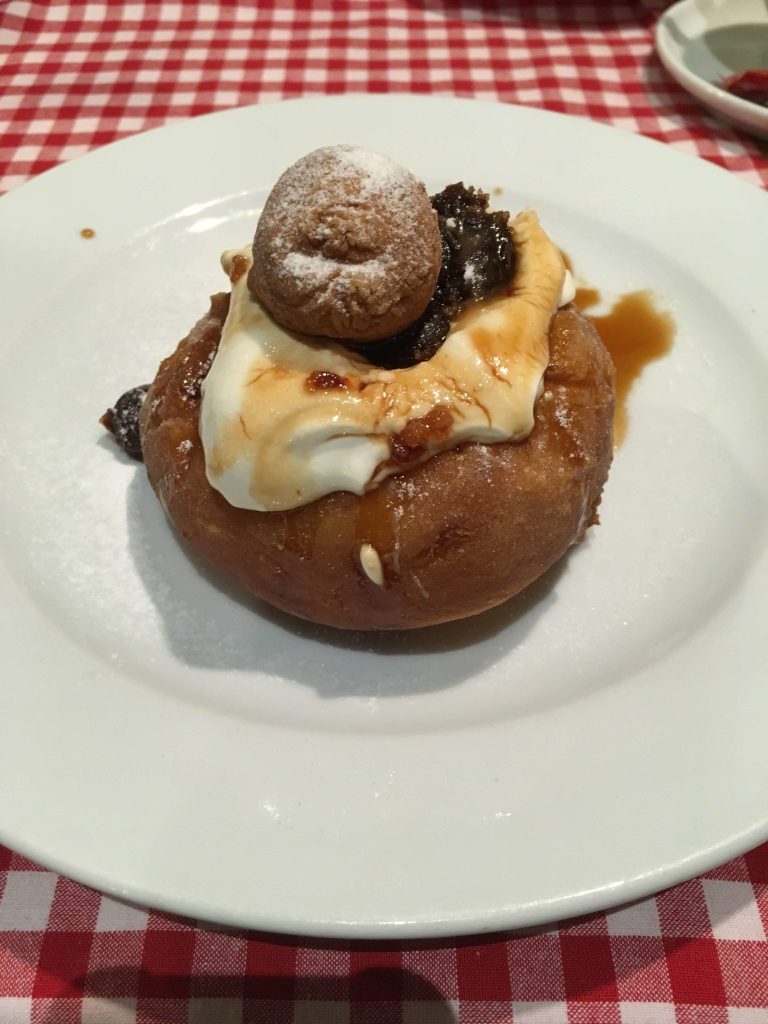
The Palace of the Parliament
We decided to walk to the Palace of the Parliament (or the parliament of Bucharest ) to check it out but also to let the food digest. The sun was about to set and, by then, the parliament was already closed. Nonetheless, we wanted to get to see it from the outside, to really confirm whether it was the second biggest building in the world.
The building of the Palace of the Parliament is the most extreme expression of the systematization program imposed by Nicolae Ceaușescu. It was constructed over a period of 13 years (although it is not already finished) in Totalitarian and modernist Neoclassical architectural forms and styles. Between 20000 and 100000 people worked on the site and project and the cost was increasing until 3 € billion.
The building is 84 meters tall and has 8 underground levels, the last one being a nuclear bunker (Nicolae feared nuclear war). So, I guess it is no wonder that such iceberg is the heaviest building in the world. As of now, out of 1100 rooms, 400 are just in use. It houses the Senate and the Chamber of Deputies, an international conference center, the National Museum of Contemporary Art, the Museum of Communism Totalitarianism and the Museum of the Palace.
There is some some sort of an esplanade surrounded by fences in front of the Parliament. I guess they open it when they host some events. We could have walked all around it to make it closer to the Parliament but, we thought that being so close, we wouldn’t be able to properly appreciate it. Thus, we stayed were we were and, I have to say, it is a damn huge building.
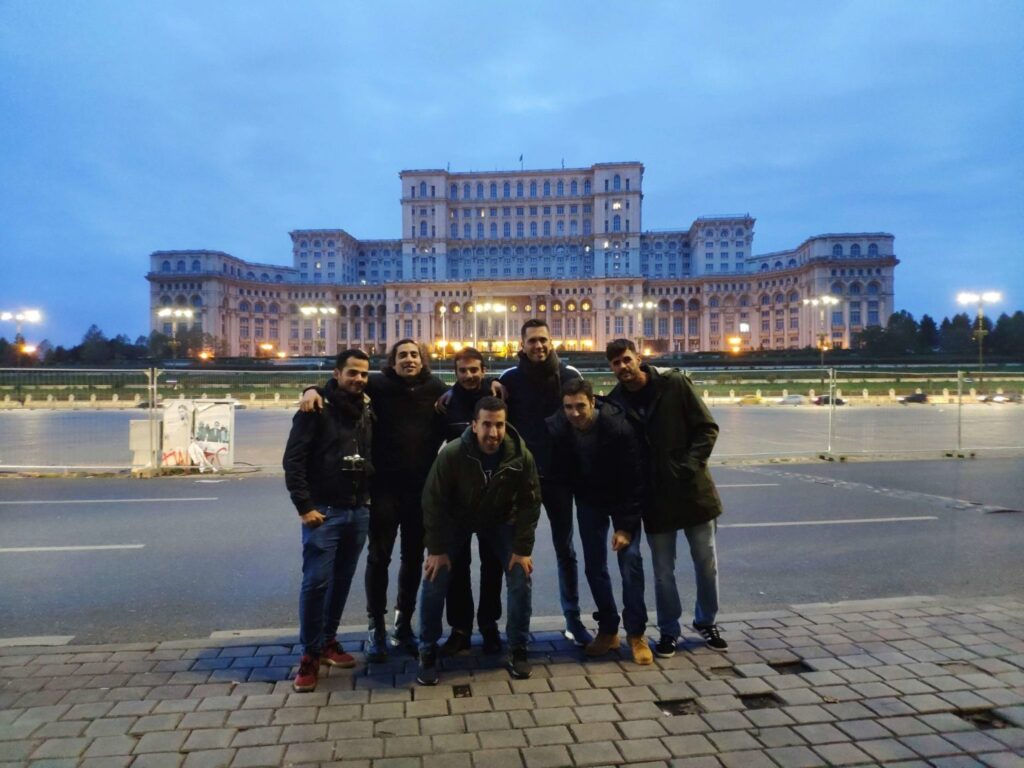
Saturday night in Bucharest
We were kind of tired after the whole day walking (and eating) so we decided to go back to the hostel, take a nap, and get ready for a Saturday night in Bucharest. After ordering a couple of Ubers, we went to “The Fabric of Bere”, also known as “The Romanian Craft Beer”. We had grabbed the first Uber so I was a little bit surprised when the guys from the other Uber called me stating they were already waiting inside. What?
We thought our driver was a little crazy. He was driving kind of fast. Guess what? The other Uber’s driver was way crazier. At a certain point, as they were passing under a bridge, he was driving at 140 Km/h. Have you ever heard the stories about the crazy Romanian driving skills? Don’t worry, you’ll get to know more about this in future posts.
The place was pretty cool and it was super crowded. We wanted to get some tasting beer but they were not serving them anymore (it was already after 21:00). Thus, we tried a pretty good red beer and also something called “the black goat”. We spent a couple of hours there enjoying the beer, the ambience and the setup of the place. Eventually, we walked back to downtown.
For dinner we didn’t go to any restaurant. We were still pretty full after City Grill and its papanasi and so we just went to a Greek fast-food place and ordered some gyros. From there, we let the city guided us and that’s how we ended sitting at a terrace, ordering some vodka, smoking narguile and enjoying life. All of that happened at “Bemolle Cafe”. We had a great time and our faces looked like this:
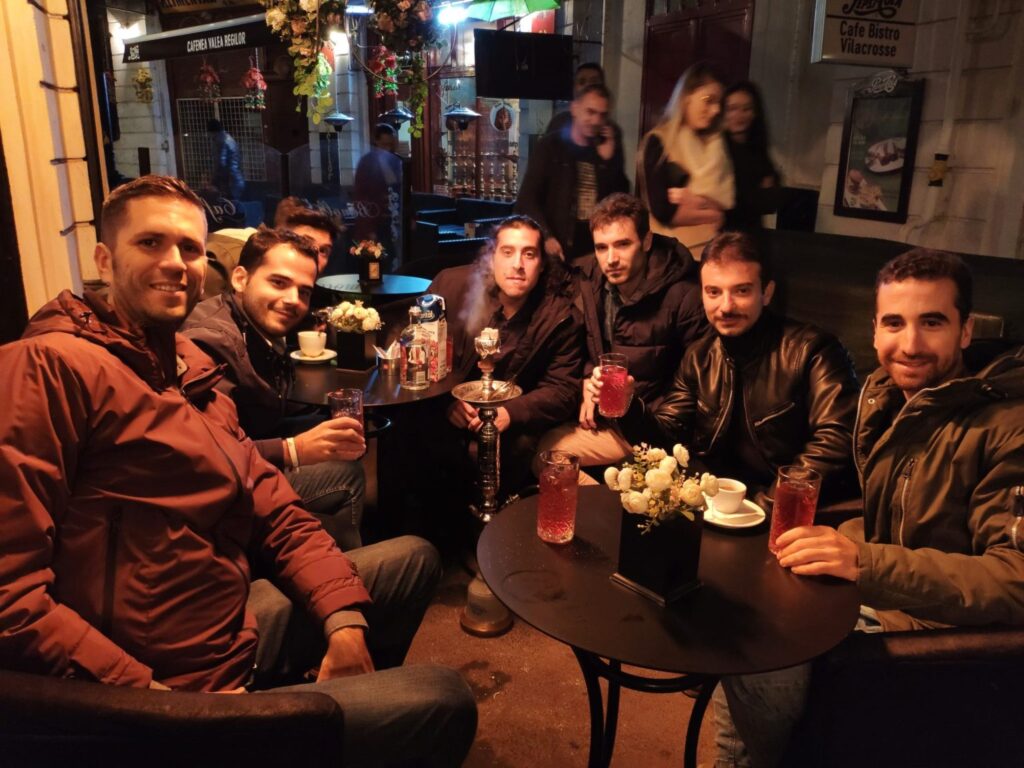
Once we were satisfied (not to say the kicked us out because they were already closing), we made it to the same street where we had been on Friday night. And, just like that, we entered once again “El Dictador”. That street (Strada Lipscani) is one of my favourites in Old Town when it comes to party. There were the same or even more people than on Friday. Streams of people walking (or crawling) from one place to another.
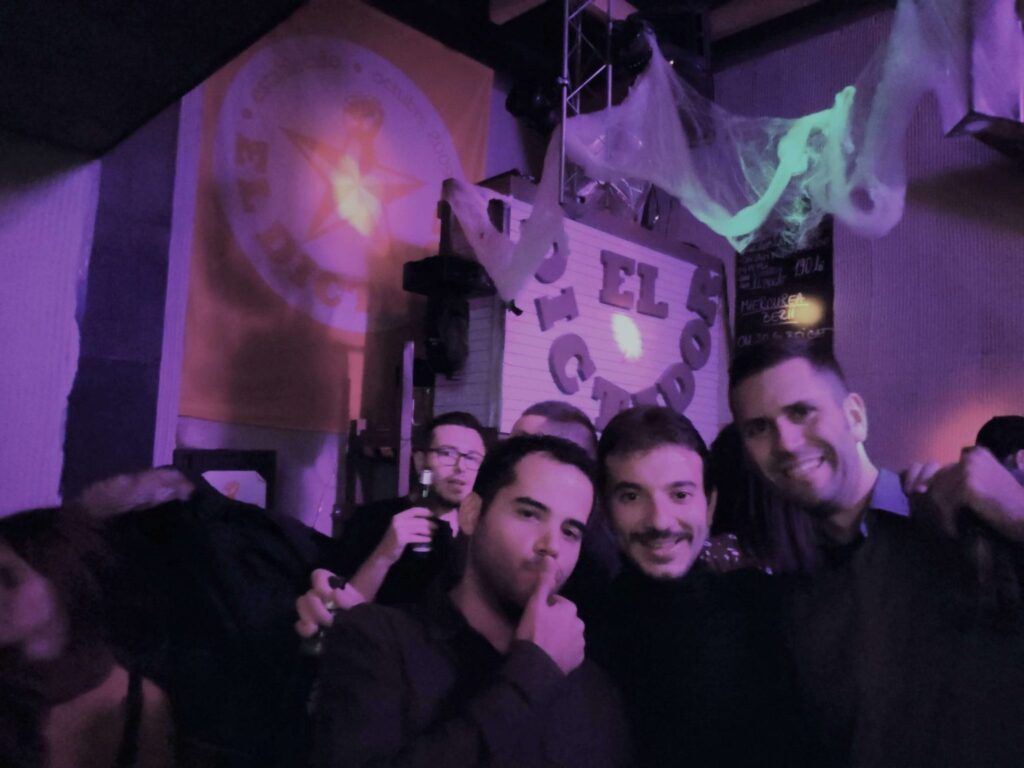
We spent most of the night at El Dictador although we also checked some of the bars around. The night was amazing except for the fact that, when I went back to find my jacket, it was gone. I guess someone there needed it more than me lol. We made it back to the hostel at around 07:00. We did it on purpose because we wanted to check the sunrise before leaving Bucharest 😆.
Ahead of us we had a couple of hours of sleep and our first drive in Romania in our rented van. The weekend in Bucharest had been truly amazing but we wanted to discover more about Romania. You’ll find more about our vicissitudes in the following posts.
So, what did you think about Bucharest? Have you ever been there? What were your impressions? Are you thinking about going visit it now, before the Euro arrives? Let me know in the comments below!
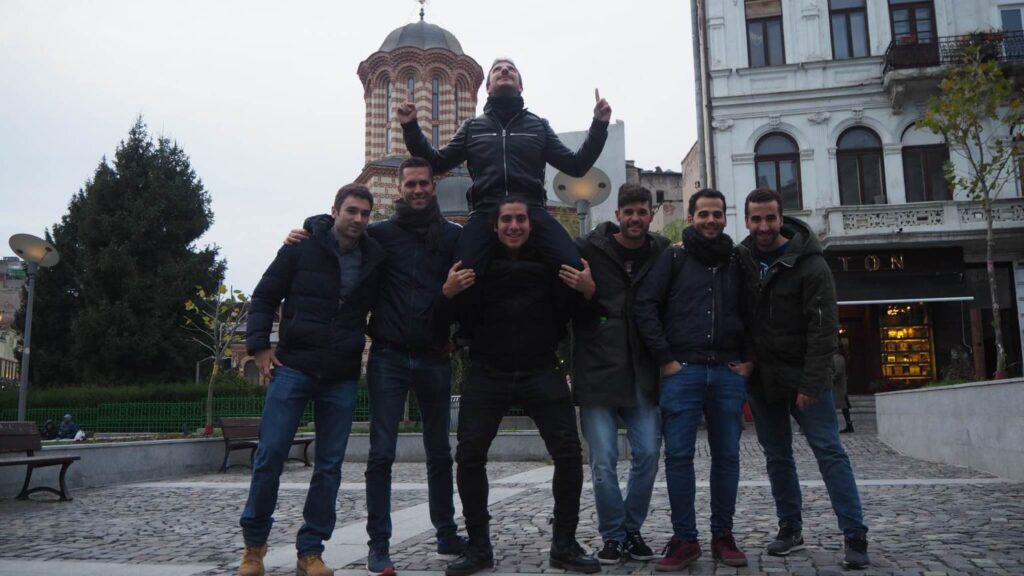


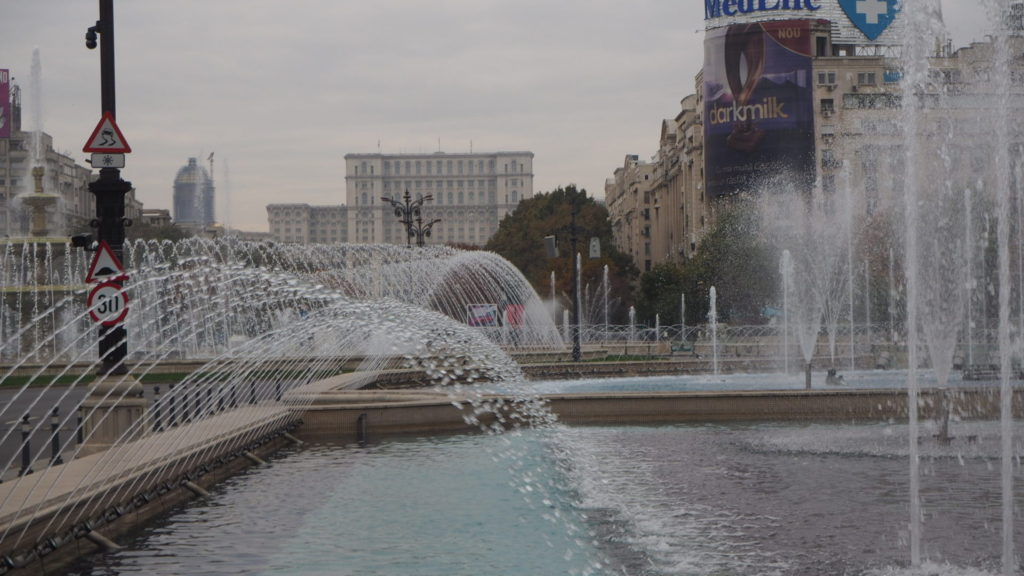





One Response
Hi Balta,
Thanks for sharing your experience!
I’ve never been in Bucharest before but now I definitely would love to visit it!
Lots of love, Nicola from Germany 🙂